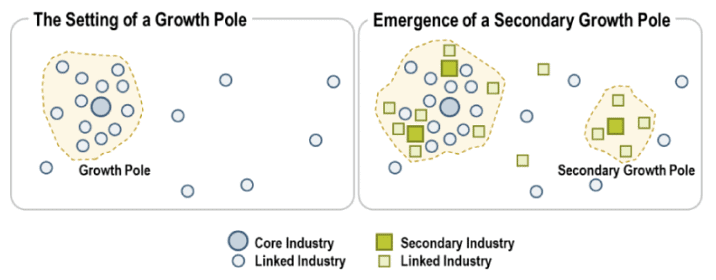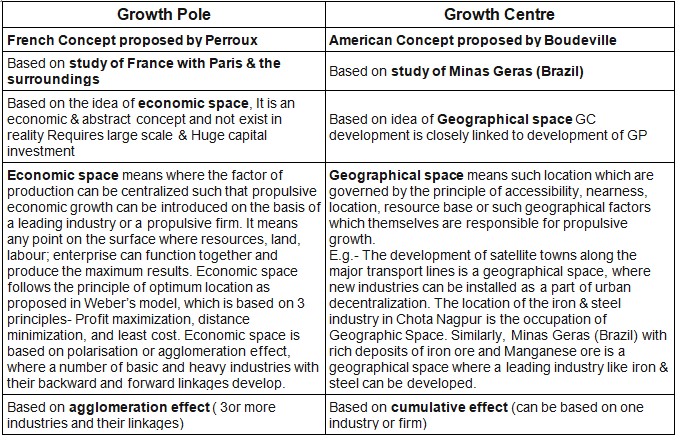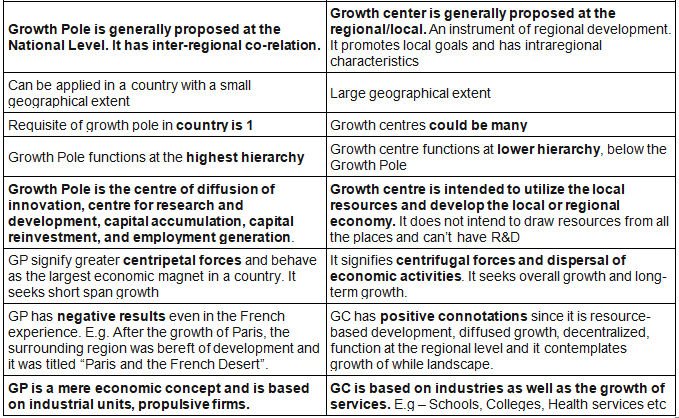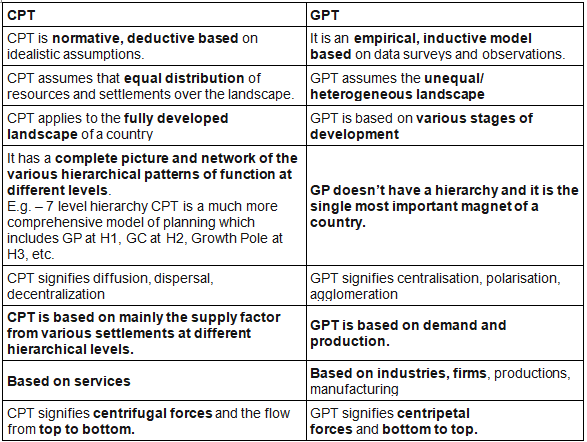UPSC Exam > UPSC Notes > Geography Optional for UPSC > Perroux and Boudeville
Perroux and Boudeville | Geography Optional for UPSC PDF Download
Growth Pole and Growth Centre Theory
- Economic development is the highest coveted goal for an economy and nation.
- Various policy frameworks, economic plans, strategies are formulated by respective govt. to resurrect the economic stagnancy
- The theory of Growth Pole & Growth Centre have been proposed by French economists with a view to resurrecting the French economy with propulsive growth in a short span of time.
- Growth Pole Theory is an inductive economic model with a geographical analysis of space. (Inductive means from particular to general)
- Growth Pole was proposed by Francois Perroux in 1955 as a part of economic planning in France, He was concerned with the phenomenon of economic development and with the process of structural change.
- The concept of Growth Centre however was proposed by Boudeville as a part of his studies in Minas Gerais (Iron ore mines- largest in Brazil).
- Boudeville gave a regional character and a specific geographic content to Perroux’s conception.
Growth Pole Theory
- Francois Perroux attempted to explain how the modern process of economic growth deviated from the stationary conception of equilibrium growth. His arguments were based on Schumpeter’s theories of the role of innovations and large-scale firms.
- In Schumpeter’s analysis, development occurs as a result of discontinuous spurts in a dynamic world. The cause of discontinuous spurts is the innovative entrepreneur whose activities take place in large-scale firms. These firms are able to dominate their environment in the sense of exercising reversible and partially reversible influences on other economic units by reason of their dimension and negotiating strength, and by the nature of their operations.
- A Growth Pole (GP) is a dynamic and highly integrated set of industries organized around a propulsive leading industry.
- E.g- the TISCO plant (Iron & steel) which leads to the establishment of a dynamic & integrated set of industries around it and is linked to it. Then the whole region around this TISCO will be known as the Growth Pole which will propel the growth of the whole region.
- The central idea of the growth poles theory is that economic development, or growth, is not uniform over an entire region, but instead takes place around a specific pole (or cluster). This pole is often characterized by core (key) industries around which linked industries develop, mainly through direct and indirect effects. Core industries can involve a wide variety of sectors such as automotive, aeronautical, agribusiness, electronics, steel, petrochemical, etc.
- Direct effects imply the core industry is purchasing goods and services from its suppliers (upstream linked industries) or providing goods and services to its customers (downstream linked industries).
- Indirect effects can involve the demand for goods and services by people employed by the core and linked industries supporting the development and expansion of economic activities such as retail.
- The expansion of the core industry implies the expansion of output, employment, related investments, as well as new technologies and new industrial sectors.
 Growth Pole Theory
Growth Pole Theory
Growth Pole Model
The growth pole model is based on following postulates:
- Concept of economic space: This theory was devised to revive France’s economy. Hence we are talking mainly about the economy.
- Concept of a leading industry: A leading industry is one that is basic and fundamental to the growth of other complementary, parasitic, peripheral industries. Cotton Textile was the leading industry in Lancashire which invited industries, manufacturing machinery (complementary industry) for cotton textile as the machines were demanded by the cotton textile industry.
- Concept of the propulsive firm: A propulsive firm means the accumulation of factors of production and the risk-taking capacity to venture into new economic sectors. A firm can be internal to an industry that functions as a part of the industry to propel its growth and proliferation. A Firm can also be external to the industries which can develop certain industries in various economic sectors.
- Concept of polarisation: Polarisation means centralization (concentration) of factors of production, resources- both physical & human, labour- both skilled & unskilled in an area. The place which develops infrastructure grows in centrality and pulls capital, resources, labours, entrepreneurship from the surrounding area. This is an essential stage for the development of the growth pole.
- Concept of linkages: Linkages means the forward and backward linkage of an industry or an economic system that is functional and interdependent and characterized by epiphytic (parasitic) tendencies E.g. Motor vehicles industry has forward linkages with the marketing, advertising, insurance, and backward linkages with iron & steel industry, rubber industry, etc Backward linkage: An industry which encourages investment in the earlier stage of production by expanding its demand for inputs Forward linkage: An industry which encourages investment in the subsequent stage of production. E.g: Loan and Banking services requirement by the motor vehicle industry
- Concept of Agglomeration: Agglomeration means the accumulation of a number of basic & heavy industries with their respective set of ancillary industries and their linkage. It involves the growth of infrastructure, R&D.
Stages of Development
- Stationary Growth: It is the stage of economic stagnancy and no utilization of resources, immobile capital, immobile capital & labour, and lesser propensity to development.
- Centralisation: It means factors of production are moving towards the economic space and new ventures, economic activities have been initiated
- Polarisation: It reflects the cumulative causation as suggested by Myrdal and a leading industry or a propulsive firm develops at the point of centralization over the economic space. In polarisation, the economic growth has started and the backwash effect (by Gunner Myrdal) can be seen which drains out the resources from surroundings, rendering them poor and backwardness surrounds the growth pole.
- Agglomerative Phase: The backwash effect is more accentuated and the surrounding areas are desertified while the centre develops into the growth pole (set of integrated and dynamic industries) and it is disproportionately larger than the other urban centres. Thus, the growth pole is developed over the economic space where polarisation and agglomeration have taken place.
- Trickle Down: This is the last phase of Growth Pole development. Trickle-down is synonymous to the spread-out effect (no scope for further development in the Growth Pole region) as suggested by Gunner Myrdal. Trickle-down was coined by Hirschmann. The benefits spread out in the otherwise desertified region. This stage is marked by
(i) Decentralisation of industries
(ii) Dispersal of capital investments
(iii) Diffusion of innovation
(iv) Diversification of industries (venturing into other industries or products)
Thus the whole landscape develops and economic equilibrium is established and due to the trickling down of benefits, the backward areas can be developed into developed areas.
Keeping in mind the Growth Pole Concept, India in 2nd Five Year Plan (Nehru- Mahalonobis Model) has established Iron & Steel Plant in Durgapur, Bhillai, and Rourkela which will act as leading industry and result in the development of the area and ultimately by Trickle Down effect. But it has not achieved that much due to any trickle-down effect.
Critical Evaluation
- The Growth Pole concept was intended for rapid economic growth in a short span of time. But in the place of its origin, it failed as reflected in the “Paris and the French Desert” (It means Paris developed and the surrounding area didn’t due to no trickle-down effect)
- Trickle-down stage and decentralization etc. have not operated the way it was proposed in the model. Growth Pole kept on growing at the cost of surroundings and benefits could not outgrow in the backward areas and it led to an ever-widening regional disparity.
- Growth Pole was projected as an alternative model to the CPT (Central Place Theory) where an idealistic distribution of various centres (production, service provider centres) were organized. But it could not serve the purpose of the overall development of a country.
- Economic space has been criticized by many scholars and Boudeville replaced it with geographical space. Economic space remains a mere fanciful idea, while geographical space was a larger reality. In the case of Paris, Economic space was feasible as Paris has minerals in the west, agriculture in the east, coasts in the south, and population in the North- such a thing is fanciful in India and the majority of other places.


R.P. Mishra:
- Indianised the theory of GP and GC (by integrating GPT, CPT, and Spatial Diffusion Theory) in his own way and presented a new hypothesis on Growth Focii (GF).
- GF is a low-order functional, an economic hub that functions at Block/Tehsil level. It was not based on industrialization rather it relies on the development of service centres.
- E.g A block-level market with an education centre, health centre, entertainment centre, evolving social institutions, social organizations, and development of social capital, making people more conscious, aware, knowledgeable to their growth perspectives, Thus, GF is based on the concept of local renaissance and development of the service sector.
- It was to act below the growth centres and the growth point. Thus for the regional development perspective, the following model can be applied.
Difference between Central Place theory (CPT) and Growth Pole theory (GPT)

The document Perroux and Boudeville | Geography Optional for UPSC is a part of the UPSC Course Geography Optional for UPSC.
All you need of UPSC at this link: UPSC
|
303 videos|636 docs|252 tests
|
FAQs on Perroux and Boudeville - Geography Optional for UPSC
| 1. What is the Growth Pole theory? |  |
Ans. The Growth Pole theory, proposed by Perroux, suggests that economic development can be stimulated by concentrating investment and infrastructure in specific areas called growth poles. These growth poles act as centers of economic activity, attracting resources, industries, and population, which eventually leads to the development of surrounding regions.
| 2. What is the Growth Centre theory? |  |
Ans. The Growth Centre theory, proposed by Boudeville, is similar to the Growth Pole theory. It emphasizes the establishment of growth centers in underdeveloped regions to promote economic growth and reduce regional imbalances. These growth centers are strategically chosen to attract investments, create employment opportunities, and stimulate overall development in the surrounding areas.
| 3. How does the Growth Pole theory contribute to economic development? |  |
Ans. The Growth Pole theory suggests that by focusing investments and infrastructure development in specific areas, economic activities can be concentrated, leading to increased productivity and growth. This concentration of resources and industries in growth poles helps in creating employment opportunities, attracting investments, and developing backward regions, thus contributing to overall economic development.
| 4. What are the key features of growth poles and growth centers? |  |
Ans. Growth poles and growth centers share several key features. They are both concentrated areas of economic activity that attract resources, industries, and population. They act as magnets for investments and create employment opportunities. Additionally, both growth poles and growth centers aim to reduce regional imbalances and promote overall development in surrounding areas.
| 5. How do growth poles and growth centers address regional disparities? |  |
Ans. Both growth poles and growth centers aim to address regional disparities by promoting development in underdeveloped or backward regions. By concentrating investments and infrastructure development in specific areas, these theories seek to stimulate economic growth, create employment opportunities, and attract resources to these regions. This, in turn, helps in reducing regional imbalances and promoting balanced regional development.
Related Searches





















